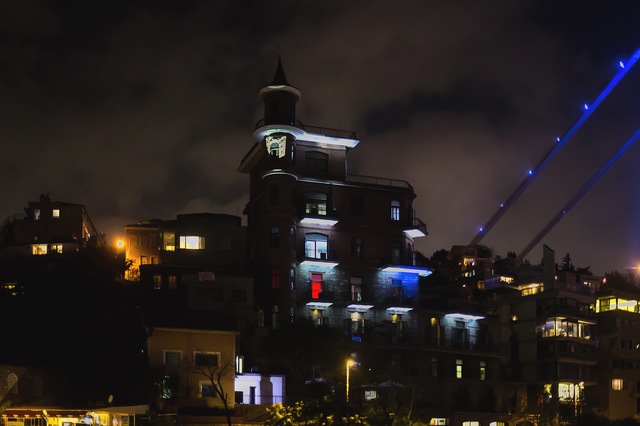In Istanbul, fragments of history are revealed by the slightest scratch in the earth. The city’s skyline is the shadow of past civilizations. Seagulls’ cries recall battles whose names are lost to memory. On winter nights the Hagia Sophia seems to be wrapped in the breath of long-departed souls. Having grown from a Greek fishing village to a global metropolis over the course of 2,600 years, Istanbul has collected rotting mansions, collapsed cisterns, crumbling tombs, and forgotten fountains as the relics of its timeless subconscious. Muslims believe in the spectral jinn, beings of smokeless fire who trick and deceive mankind. Turkish legend tells of the gulyabani, a hair-covered monster that lurks in graveyards, waiting to devour travellers. It is therefore no surprise that Istanbul’s streets are overflowing with tales of mystery that its inhabitants have retold through the centuries.
On the shoreline of Baltalimanı, a red tower topped by a conical roof rises five stories into the air. The building’s outline against the Fatih Sultan Mehmet Bridge could be the setting for a Shakespearean tragedy or one of Edgar Allan Poe’s dark tales. The mansion is aptly known as Perili Köşk, meaning “the haunted mansion.” Though Ottoman statesman and diplomat Yusuf Ziya Paşa ordered its construction in the 1910s, work on the grand house was soon halted by the outbreak of World War I. According to legend, Yusuf wanted the house to match the beauty of his Egyptian wife, who – maybe seeing the end of the Ottomans on the horizon – left Yusuf for her home country. When two of the pasha’s merchant ships sank at sea, poor finances forced him to leave most of the house unfinished. Yusuf died in 1926 and was buried within sight of the Nile, asking for his tomb to be built of stones from the ill-fated mansion.
The pasha’s second wife and his three daughters remained in the house after Yusuf died, selling the building to its current owner in 1993. Local people began to tell stories about a ghostly woman who would appear at the windows of the abandoned mansion. When restoration began in 1995, workers claimed to see the pasha’s second wife walking the corridors. Borusan Holding holds the lease of Perili Köşk today, using it as an office space during the week. The mansion is open to the public on weekends as Borusan Contemporary, an Istanbul art institution with excellent permanent and temporary exhibitions. But visitors might want to bring a friend – you never know when the pasha’s wife might walk around the corner. Baltalimanı Hisar Caddesi No. 5, Rumeli Hisarı.
Though its location on crowded İstiklal Caddesi renders it less noticeable than Yusuf Ziya Paşa Mansion, the Palais de Hollande hides some equally haunted history behind its iron gates. The first written evidence of relations between the Dutch government and the Ottoman Empire dates from 1612, and the plot on İstiklal Caddesi (at that time called the Grand Rue de Pera) was bought in 1700 by Holland’s envoy Jacobus Coljer. Istanbul’s tightly packed wooden buildings were vulnerable to fire, and the Dutch property burnt to the ground in 1767 and again in 1831. The stone structure that we see today was built in 1859, mimicking the style of an Italian palazzo. A series of stone vaults leading onto the back garden are all that remains of the original building – unless we count some supernatural phenomena.
This story begins with art lover and diplomat Cornelis Calkoen’s appointment to Istanbul in 1727. Calkoen was active in promoting trade between the Netherlands and the Ottoman Empire, and he also commissioned many Ottoman-themed paintings by French painter Jean-Baptiste Vanmour. This was the peaceful Tulip Era, when the Ottoman Empire experienced a blossoming of culture that included its first printing press, the hedonistic poetry of Şair Nedim, a revival of miniatures painting, and a move towards liberal European values.
As it turned out, ambassador Calkoen had an eye not only for the visual arts but also for women – in particular a Circassian ex-slave called Beyazgül (White Rose). The spirit of the time permitted their unusual relationship, but the Dutch government was not so kind, recalling Calkoen to the Netherlands after almost 20 years in Istanbul. As hard as Calkoen tried to return, his government insisted on posting him to different countries around Europe. When the moment finally came for his return, Calkoen died at age 67 before he could see Istanbul again. He had never married or had children.
Meanwhile, the faithful Beyazgül still expected Calkoen to arrive. She had never received the news of Calkoen’s death, dying herself while waiting at the gates of the Palais de Hollande. A small statue commemorates the doomed love of Beyazgül in the consulate’s garden. But this is not the only reminder. Staff working in the building have reported ghostly footsteps, window shutters that move by themselves, and even apparitions in the bedrooms at night. Could it be that Beyazgül is still waiting there for Calkoen to return? İstiklal Caddesi No. 197, Beyoğlu
Standing on the Asian shore of the Bosphorus opposite Çırağan Palace is a third monument to noble tragedy. Recognizable by the squat turret above its white wooden walls, this mansion was built for statesman Cemil Molla, son of the poet Süleyman Celaddin Bey and grandson of chief cleric Uryanizade Ahmed Esad Efendi. Cemil Molla Köşkü, as the building is known, was the first house outside the sultan’s palace to have a telephone, central heating, and lights powered by a diesel engine. The enlightened Cemil Molla turned his home into a focal point of high society, hosting discussions on philosophy and poetry during the day while the nights were filled with the joyful sounds of piano and tanbur.
When his youngest daughter’s wedding day came, Cemil wanted to arrange a legendary ceremony, and took out large loans for the purpose. The family thought the loans would be easy to pay off, but the last days of the Ottoman Empire were not financially stable. By the time Cemil died in 1938, the new Republic had wiped out his Ottoman prestige, and the mansion began to fall into disrepair. As the family’s debts piled up, the authorities seized the building and sold it to Kahveci Cemil Bey and his family. When his son died in a car accident and Kahveci Cemil Bey died soon after, the new owner’s wife left the cursed mansion and moved to a new house in the garden.
Local people reported that Cemil Molla’s ghost would stalk the grounds at night. From the 1950s to the 1980s, potential buyers were discouraged by these tales. In the meantime the house’s white façade had turned black with rot. Mesa Holding finally bought the plot in 1986 with the intention of building modern luxury housing. But the house that had seen so much sadness refused to die – the government stepped in to save Cemil Molla Köşkü for its historical significance. Today the building stands restored to its original glory with a fresh coat of paint, and it survives as Mesa Holding’s Istanbul office. Abdullahağa Caddesi No. 23, Üsküdar ✪
![[Futuristika!]](https://futuristika.org/wp-content/uploads/2020/12/futuristika-logo.png)

